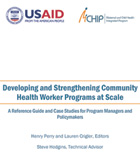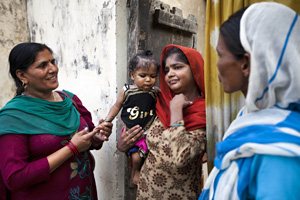
New Publication Spotlight: Recruitment of Community Health Workers
Recruiting and selecting the most appropriate person to fill the role of a community health worker is a vital element of a functional local health system. Community health workers are often the only ones able to reach critical populations in underserved areas, and are key to providing family planning, HIV, and other essential services as countries move toward universal health coverage. A chapter on community health worker recruitment by Wanda Jaskiewicz and Rachel Deussom of CapacityPlus/IntraHealth International appears in MCHIP’s new publication, Developing and Strengthening Community Health Worker Programs at Scale: A Reference Guide and Case Studies for Program Managers and Policymakers.
A chapter on community health worker recruitment by Wanda Jaskiewicz and Rachel Deussom of CapacityPlus/IntraHealth International appears in MCHIP’s new publication, Developing and Strengthening Community Health Worker Programs at Scale: A Reference Guide and Case Studies for Program Managers and Policymakers.
MCHIP’s new publication provides a review of issues and questions to consider when addressing issues relevant for large-scale community health worker programs. It offers a framework for those in leadership positions as they consider how to develop, expand, and strengthen their community health worker programs. Many examples from programs around the world are included. An appendix contains case studies, a summary of perspectives on large-scale programs, and important resources.
Key questions, recommendations, and challenges for recruitment
Chapter 8, Recruitment of Community Health Workers, considers key questions, recommendations, and challenges for planning and implementation of recruitment, including selection, resource availability, and retention.  The authors make three main points:
The authors make three main points:
- Developing appropriate recruitment policies and processes is a critical feature of an effective large-scale community health worker program.
- Community engagement in recruitment is highly desirable, but managing this in a way that is productive requires careful planning and adaptation.
- An effective recruitment program can help reduce attrition, which is a major challenge for many large-scale community health worker programs.
“The value of a community health worker who knows the challenges or barriers to health care cannot be underestimated,” Deussom notes. “They are essential for connecting people to services, especially for underserved or marginalized communities. I have witnessed first-hand the power of an effective community health worker who visited with a very sick young man to respectfully but persuasively convince his family that he needed to get tested for HIV. Before speaking to that community health worker, his family had given up hope. Years later, he is healthy, strong, and employed.”
To learn more, read the chapter on recruitment and check out the complete MCHIP publication.
Help CapacityPlus spread the word about strengthening the health workforce. Follow us on Twitter and like us on Facebook.
Related items:
Photo by Trevor Snapp, courtesy of IntraHealth International (Two community health workers in India talk with a mother whose malnourished child was restored to good health thanks to their collective efforts)


